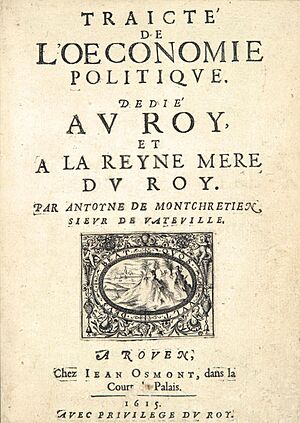Antoine de Montchrestien facts for kids
Quick facts for kids
Antoine de Montchrestien
|
|
|---|---|

Traicté de l'oeconomie politique (1615) written by Antoyne de Montchrétien
|
|
| Born | 1574 |
| Died | October 1621 (aged 46) Les Tourailles
|
| Occupation | Soldier, Dramatist, Adventurer and economist |
Antoine de Montchrestien (born around 1575, died in October 1621) was a French soldier, writer, adventurer, and economist. He is famous for writing plays and for coining the term "political economy."
Contents
Who Was Antoine de Montchrestien?
Antoine de Montchrestien lived in France during the late 1500s and early 1600s. He was a very busy person. He was a soldier, a writer of plays, and an adventurer. He also wrote about how countries manage their money and resources.
Early Life and His First Plays
Montchrestien was born in Falaise, a town in Normandy, France. He became an orphan when he was young. Luckily, a kind baron named François Thésart helped him. Antoine worked for the baron's children, which allowed him to study alongside them. Later, he even married the baron's daughter, Suzanne.
Antoine first wanted to be a writer. In 1595, he published his first play, a tragedy called Sophonisbe or La Carthaginoise. A tragedy is a serious play, often with a sad ending.
In 1601, he published five more plays. These included tragedies like L'Ecossaise (about Mary Stuart) and David ou l'Adultère. He also wrote a pastoral play called La Bergerie, which is a play about shepherds and country life.
A Life of Adventure and Challenges
Montchrestien was involved in some serious conflicts. In 1603, he was badly hurt. In 1604 or 1605, he was involved in another conflict where someone died. Because of this, he had to leave France for a short time and went to England.
He dedicated one of his plays, L'Ecossaise, to King James I of England. With the king's help, he was allowed to return to France. When he came back, he started a steel factory in a place called Auxonne-sur-Loire.
A New Idea: Political Economy
In 1615, Montchrestien published a very important book called Traicté de l'économie politique. This book was special because it was the first time the term "political economy" was used in the title of a major work.
In his book, Montchrestien talked about how politics and money-making are connected. He believed that a country's wealth and how people work are important for a stable government. He thought that making things and earning money helped a country stay strong.
Around this time, Montchrestien was given several important jobs by the government. He even became the governor of Châtillon-sur-Loire in 1617. These jobs helped him earn more money, and he took on the title "baron."
His Final Years
In 1620, Montchrestien joined a group called the Huguenots who were fighting against the king. He had to fight against people he once knew, like the prince de Condé, who had helped him before.
He was unable to hold the city of Sancerre. Montchrestien went back to Normandy to try and gather more fighters. On the night of October 7, 1621, he was found in an inn near Falaise and was killed. After his death, he was punished by the law for opposing the king.
Montchrestien's Theater Style
Antoine de Montchrestien is considered one of the important founders of French drama in the 1600s, along with Robert Garnier and Alexandre Hardy.
His tragedies followed certain rules. They had five acts, were written in verse, and often used a chorus. Important events, like battles, usually happened off-stage and were described by messengers.
Montchrestien paid close attention to details in his writing. He worked hard to make his verses sound good. He liked to include sad speeches (laments) and wise sayings in his plays.
Sometimes, his plays are criticized for not having enough action. For example, in his play L'Ecossaise, Queen Elizabeth first forgives Mary, Queen of Scots, but then Mary is executed without a clear reason for the change. In his play Hector, the main character, Hector, suddenly rushes into battle without explanation.
Despite the lack of action, Montchrestien's plays often had big debates about ideas. For example, they explored questions like:
- Is it better to seek glory or be careful?
- Does being careful affect your reputation if others make fun of it?
- Is your duty to your family and king more important than your personal honor?
- Is true goodness only seen through actions?
These kinds of debates in his plays were similar to the works of later famous playwrights like Pierre Corneille. Montchrestien's emotional female characters, who were affected by dreams and bad signs, also remind us of the sad female characters in Corneille's plays.
His play Aman has even been compared to Jean Racine's famous play Esther. The strong hatred of Haman for Mordecai in Montchrestien's play is often seen as more powerful than in Racine's version.
Montchrestien was a poet, an economist, a factory owner, and a soldier. He shows how people in his time often had many different skills and jobs before writing became a full-time profession.
See Also
Works
- Montchrestien, Antoine de, 1615. Traicté de l'oeconomie politique. F. Billacois, ed., 1999, critical-edition preview.

